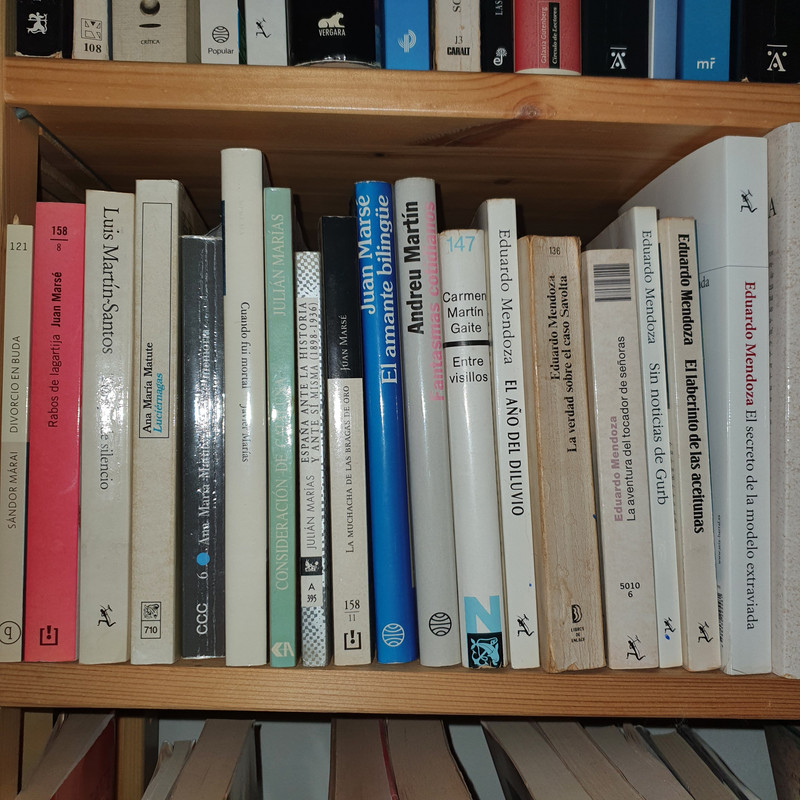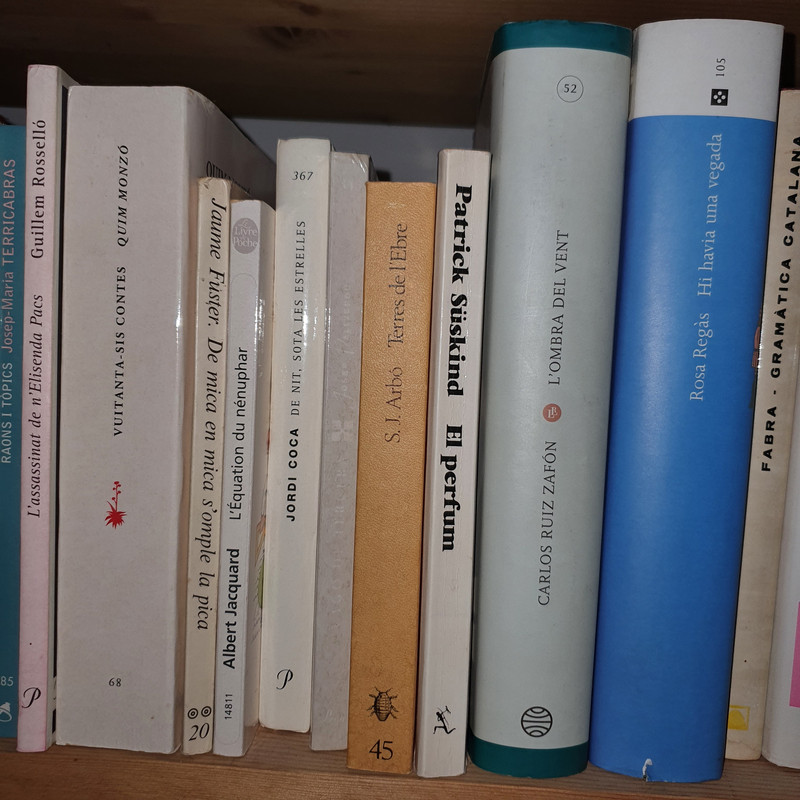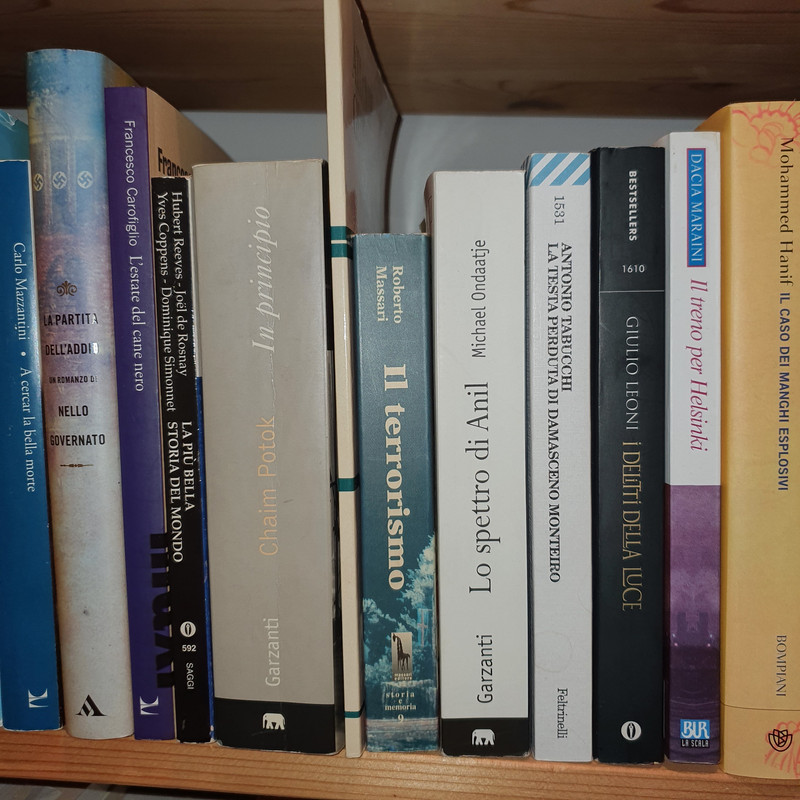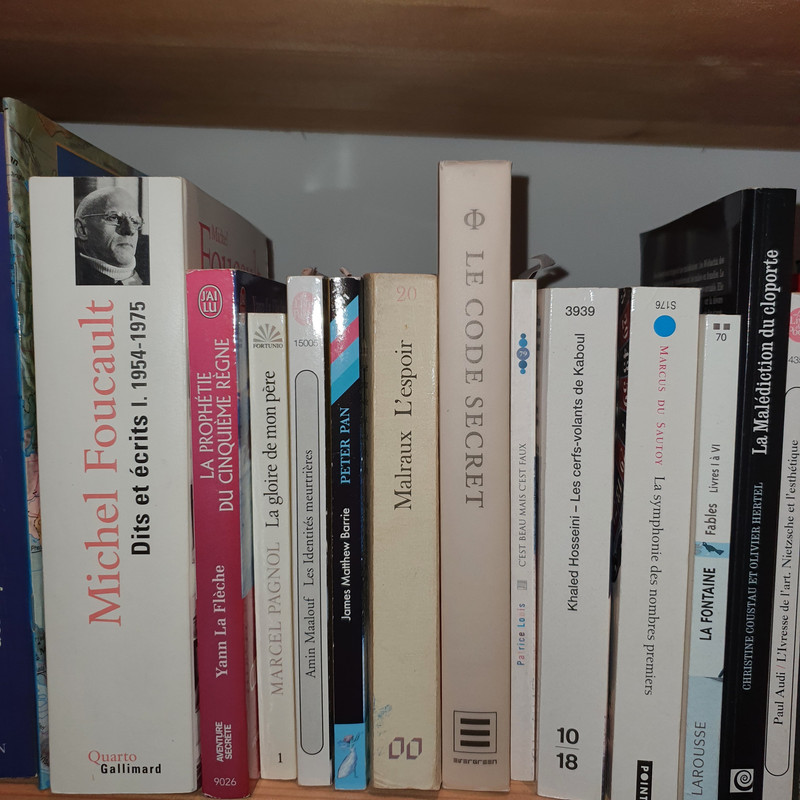Me too. (Annoyed by it, not having multilingual children)
But you can always do that: you either tilt your head to the right or to the left depending on the book. The funny movement is the alternate tilting left - right - left - right when the books are not sorted by language. Or when, like the French books in the picture above, they are printed both ways.
I think books in Spanish are written both ways too, I have vivid memories of doing neck exercises in the bookstore (as you say: tilt left - tilt right - tilt left) and all the books were in Spanish.
The general rule for English text direction is first left to right and then top to bottom. Thus spines, without left to right extent, are written top to bottom.
It is very interesting indeed that other languages either don’t have the top to bottom rule or override it in the specific case of spines.
Spanish: both ways

Catalan: mostly bottom to top, but some are the other way around

Italian: mostly top to bottom, but some are the other way around

French: mostly bottom to top, but some are the other way around

German: bottom to top
English: top to bottom
This may be the reason I had not noticed the regularity. There is not so much of it in my shelfs.
I had a book of mine translated into French, Spanish, Polish, and Slovakian. Only the Slovakian used the American style.
IMHO, it’s the responsibility of the person asking the question to ensure that there
is no ambiguity in the question.
I have the book Winnie ille Pu
Those are all the books, or just small snapshots of longer rows of books? Whatever the case, it doesn’t seem anyone is too religious about their choice.
Religious? I had no need of that hypothesis.
Consider a trilogy, say, of books, sitting flat in a stack on a desk. In what order should they be stacked? I would put The Return of the King on the bottom, then The Two Towers on top of that, and The Fellowship of the Ring on top of the whole stack. This puts the last page of Fellowship right next to the first page of Towers, and the last page of Towers next to the first page of King, same as they would be if all three were published in one volume.
But now take those same three books, and put them on a bookshelf. They’ll now be in reverse order. Put them in order from left to right, and now the first page of Fellowship is next to the last page of Towers, and the first page of Towers is next to the last page of King.
And I thought when I started typing this post that this had some relation to the two different ways of writing titles on the spines, but now that I typed it all out and think about it, I think that you get this problem with both the American and European styles.
I’m guessing this explains the name of a disease that means “severely weak muscles”:
Indeed: Asthenia or asthaenia, from Greek ἀσθένεια, is composed of α [a] —negating alfa—: “lack”, and σθένος [sthénos]: “stregth”, “power”, literally lack of strength and also disease. In the special case of myasthenia the Greek praefix μῦς (mys) means muscle, so it describes muscular weakness. Gravis makes this even worse.
This mys is cognate to the latin musculus, also meaning muscle, and through Linnaeus gave us the Latin names of the house mouse, mus musculus, and the blue whale, Balaenoptera musculus
Parturiunt montes, et nascetur ridiculus mus.
Useful insult for a disappointing outcome of lots of effort/fuss/fanfare
I was musing on “ring”, and whether the noun preceded the verb. The noun seems to go all the way back to PIE, but it looks as though the verb may as well. I guess a bell (which is circular, like a ring) makes a sound that goes out evenly in all directions.
According to this (generally reliable) source, these are two, unrelated words:
…but associations like the one you mentioned are sometimes the sorts of things that help solidify two look-alike words, via folk etymology.
It’s cool that the PIE root of “ring” as a circular object also gives us “circle” and “curve,”. Sker > skring > hring > ring versus sker > ker > circle, curve
One of the few words in any IE language that preserves the original “s” in PIE “sker” is “shrine,” originally meaning a reliquary or jewel-box, which must derived from a curved or roughly circular container. (Like a Shriner’s hat! ![]() )
)
I remember now; there was a 19th century story in which a man was accidentally “danced to death” by a mechanical woman. He had a pre-existing heart problem as I recall. Does that ring a bell? I thought it was in an Anthony Trollope novel, but I can’t find it in the novel where I thought it was.
That was English humorist Jerome K. Jerome. It appeared in the March 1893 issue of The Idler and later was incorporated into his book/collection Novel Notes. It’s title shifted over appearances but now is known as “The Dancing Partner.”
However, that clockwork automaton was a male and a woman was his victim, because the inventor forgot to give the automaton an off switch. I suppose someone could have switched the sexes as a follow-up - hack writers have always existed - but more likely your memory is faulty. You can check at the link I gave.
If someone knows of your version, of course I’d like to be corrected.
